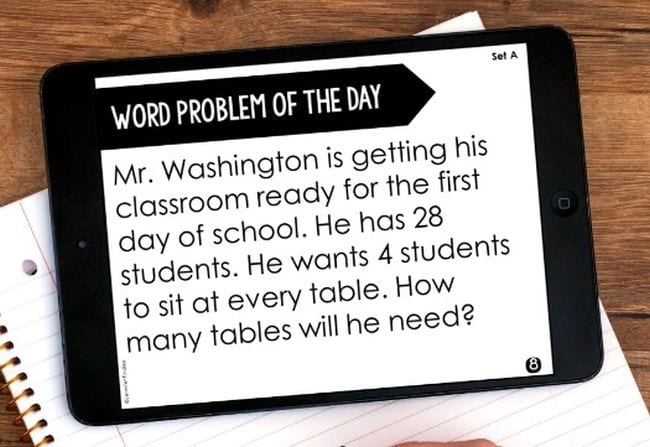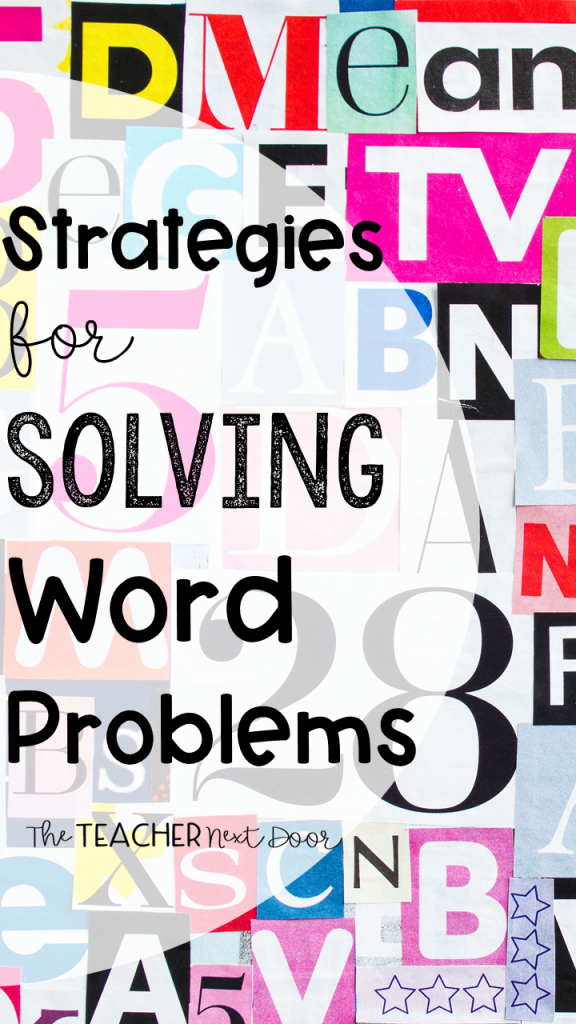
It’s one thing to solve a math equation when all of the numbers are given to you but with word problems, when you start adding reading to the mix, that’s when it gets especially tricky.
The simple addition of those words ramps up the difficulty (and sometimes the math anxiety) by about 100!
How can you help your students become confident word problem solvers? By teaching your students to solve word problems in a step by step, organized way, you will give them the tools they need to solve word problems in a much more effective way.
Here are the seven strategies I use to help students solve word problems.
1. Read the Entire Word Problem
Before students look for keywords and try to figure out what to do, they need to slow down a bit and read the whole word problem once (and even better, twice). This helps kids get the bigger picture to be able to understand it a little better too.
2. Think About the Word Problem
Students need to ask themselves three questions every time they are faced with a word problem. These questions will help them to set up a plan for solving the problem.
Here are the questions:
A. What exactly is the question?
What is the problem asking? Often times, curriculum writers include extra information in the problem for seemingly no good reason, except maybe to train kids to ignore that extraneous information (grrrr!). Students need to be able to stay focused, ignore those extra details, and find out what the real question is in a particular problem.
B. What do I need in order to find the answer?
Students need to narrow it down, even more, to figure out what is needed to solve the problem, whether it’s adding, subtracting, multiplying, dividing, or some combination of those. They’ll need a general idea of which information will be used (or not used) and what they’ll be doing.
This is where key words become very helpful. When students learn to recognize that certain words mean to add (like in all, altogether, combined), while others mean to subtract, multiply, or to divide, it helps them decide how to proceed a little better
Here’s a Key Words Chart I like to use for teaching word problems. The handout could be copied at a smaller size and glued into interactive math notebooks. It could be placed in math folders or in binders under the math section if your students use binders.
One year I made huge math signs (addition, subtraction, multiplication, and divide symbols) and wrote the keywords around the symbols. These served as a permanent reminder of keywords for word problems in the classroom.
If you’d like to download this FREE Key Words handout, click here:
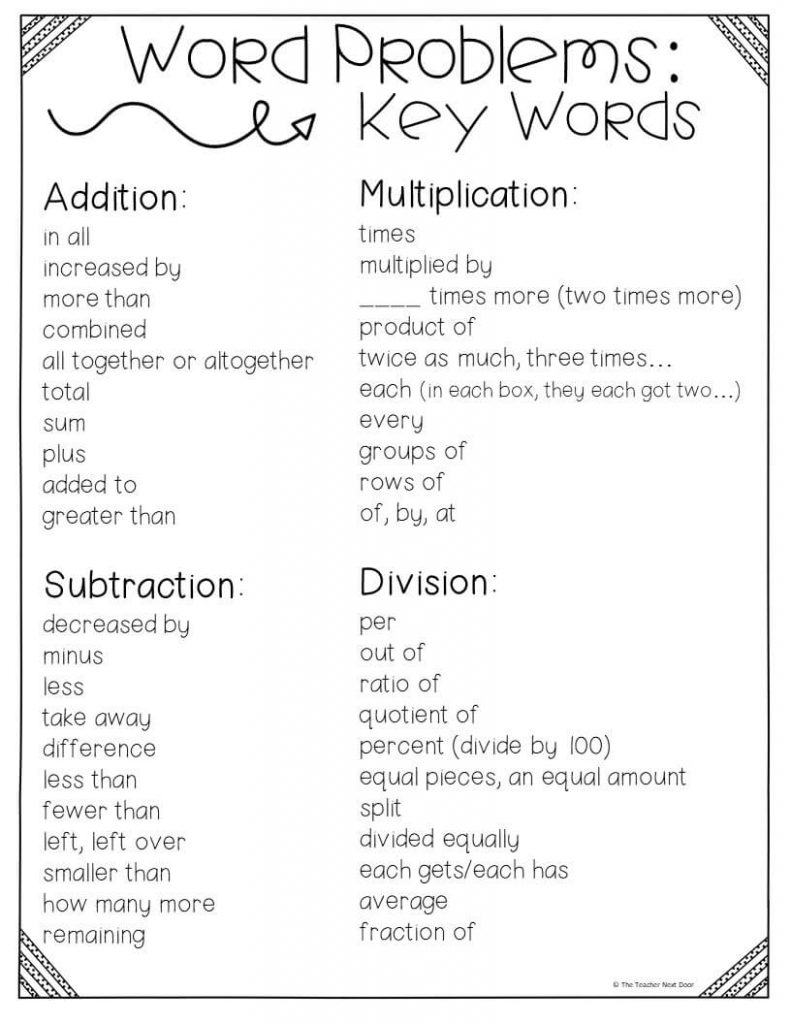
C. What information do I already have?
This is where students will focus in on the numbers which will be used to solve the problem.
3. Write on the Word Problem
This step reinforces the thinking which took place in step number two. Students use a pencil or colored pencils to notate information on worksheets (not books of course, unless they’re consumable). There are lots of ways to do this, but here’s what I like to do:
- Circle any numbers you’ll use.
- Lightly cross out any information you don’t need.
- Underline the phrase or sentence which tells exactly what you’ll need to find.
4. Draw a Simple Picture and Label It
Drawing pictures using simple shapes like squares, circles, and rectangles help students visualize problems. Adding numbers or names as labels help too.
For example, if the word problem says that there were five boxes and each box had 4 apples in it, kids can draw five squares with the number four in each square. Instantly, kids can see the answer so much more easily!
5. Estimate the Answer Before Solving
Having a general idea of a ballpark answer for the problem lets students know if their actual answer is reasonable or not. This quick, rough estimate is a good math habit to get into. It helps students really think about their answer’s accuracy when the problem is finally solved.
6. Check Your Work When Done
This strategy goes along with the fifth strategy. One of the phrases I constantly use during math time is, Is your answer reasonable? I want students to do more than to be number crunchers but to really think about what those numbers mean.
Also, when students get into the habit of checking work, they are more apt to catch careless mistakes, which are often the root of incorrect answers.
7. Practice Word Problems Often
Just like it takes practice to learn to play the clarinet, to dribble a ball in soccer, and to draw realistically, it takes practice to become a master word problem solver.
When students practice word problems, often several things happen. Word problems become less scary (no, really).
They start to notice similarities in types of problems and are able to more quickly understand how to solve them. They will gain confidence even when dealing with new types of word problems, knowing that they have successfully solved many word problems in the past.
If you’re looking for some word problem task cards, I have quite a few of them for 3rd – 5th graders.
This 3rd Grade Math Task Cards Bundle has word problems in almost every one of its 30 task card sets.
There are also specific sets that are dedicated to word problems and two-step word problems too. I love these because there’s a task card set for every standard.
CLICK HERE to take a look at 3rd grade:
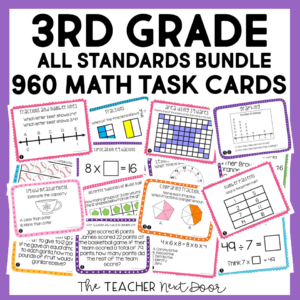
This 4th Grade Math Task Cards Bundle also has lots of word problems in almost every single of its 30 task card sets. These cards are perfect for centers, whole class, and for one on one.
CLICK HERE to see 4th grade:
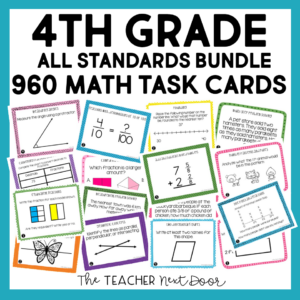
This 5th Grade Math Task Cards Bundle is also loaded with word problems to give your students focused practice.
CLICK HERE to take a look at 5th grade:
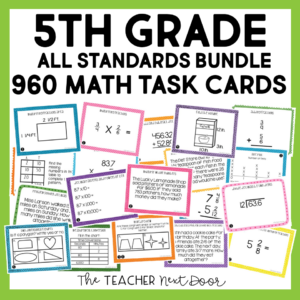
Want to try a FREE set of math task cards to see what you think?
3rd Grade: Rounding Whole Numbers Task Cards
4th Grade: Convert Fractions and Decimals Task Cards
5th Grade: Read, Write, and Compare Decimals Task Cards
Thanks so much for stopping by!

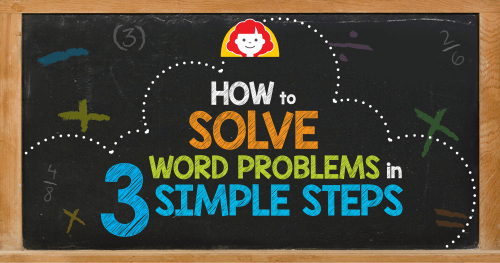
3-Step System
1. Read: Read the problem and decide what the question is asking.
- Read the problem 2 times or more.
- Underline or circle key words, phrases, and numbers. Draw a line through irrelevant information.
2. Plan: Think about what the story is asking you to do. What information are you given, and what do you need to find out?
- Draw a picture.
- Circle or underline key words. (Use highlighters or crayons to color-code key numbers and phrases.)
- Write out the question in your own words.
3. Solve: What strategy could you use to find the missing information: addition, subtraction, multiplication, or division?
- Write a number sentence and solve.
- Use counters.
- Create charts.
Check your work by explaining your reasoning. Does your answer make sense?
Download this free strategy checklist from Math Fundamentals to help your child solve word problems.
Different Strategies to Solve Word Problems
Everyone learns in a different way. What makes sense to one individual often isn’t the easiest option for another. Incorporating different strategies to solve word problems can help your child discover what strategy works best for him or her. A few tips to use are:
1. Circle numbers in a story and underline key phrases.
Color coding is a fun method to incorporate to help children decide what operation the question is asking for. Assign a color to each operation and highlight the phrase that identifies it. For example, red links to addition and blue links to subtraction.
2. Incorporate a key word list.
Key word lists are best used for teaching younger children how to solve word problems. As math curriculum advances, children should not be dependent on a key word list to solve a problem. The questions get trickier.
Addition
In all
Together
Total
Altogether
Combine
Sum
Join
Subtraction
Difference
Fewer
How many more
How much more
Left
Remain
Less
3. Visuals
If your child is a visual learner, drawing a picture or using counters can help him or her understand what the problem is asking. Use number lines, charts, or counters or draw a picture.
4. Write your own word problem.
Knowing what is needed to write a word problem is the first step in identifying key words to solve a story. Take turns writing your own word problems with your child and exchange them to solve.
5. Stay organized.
It is important to write clearly and keep work space neat so children can read and follow their own computations. Many children need a separate piece of paper to allow them enough space to solve and understand their answer. Graphing paper is a great option to help students record neat work.
Download this free sample word problem from Math Fundamentals, grade 1.
How to solve a two-step word problem
In a two-step word problem children are being asking to solve two related equations. These can get tricky for children to understand when they transition from one-step to two-step problems. Help your child understand his or her relationships within two-step word problems with these strategies:
1. Circle important information.
Circle numbers and important phrases that ask questions. The number sentences needed to solve these equations are hidden in those asking questions. Identify the first and second questions needed to solve.
2. Distinguish the two parts of the problem.
First identify the first step of the first part of the word problem. Write a number sentence and solve.
3. Use the answer from the first-step solution to the whole problem.
Use the answer from the first question to help you solve the next equation. What operation does the second question require?
Check your work by explaining your reasoning. What was the question answered? Is the answer reasonable for the question being asked?
Download this free sample two-strategy word problem from Math Fundamentals, grade 2
Download this free sample multi-strategy word problem from Math Fundamentals, grade 4
Evan-Moor’s Math Fundamentals is a great resource for training students how to solve word problems in 3 simple steps. It provides step-by-step directions for solving questions and guides children with helpful visuals and key phrases.
Check out Daily Word Problems for consistent practice solving word problems.
For more fun math tips and strategies check out our Math- Ideas, Activities and Lessons Pinterest Board.
Save these tips and Pin It now!

Related Pages
Basic Algebra
Combining Like Terms
Solving Equations
More Algebra Lessons
Step 1: Translate the problem into equations with variables
First, we need to translate the word problem into equation(s) with variables.
Then, we need to solve the equation(s) to find the solution(s) to the
word problems.
Translating words to equations
How to recognize some common types of algebra word problems and how to solve them step by step.
The following shows how to approach the common types of algebra word problems.
Age Problems usually compare the ages of people.
They may involve a single person, comparing his/her age in the past, present or future.
They may also compare the ages involving more than one person.
Average Problems involve the computations for
arithmetic mean or
weighted average of different quantities.
Another common type of average problems is the average speed computation.
Coin Problems deal with items with denominated values.
Similar word problems are Stamp Problems and
Ticket Problems.
Consecutive Integer Problems deal with consecutive numbers.
The number sequences may be Even or
Odd, or some other simple number sequences.
Digit Problems involve the relationship and manipulation of digits in numbers.
Distance Problems involve the distance an object travels at a rate over a period of time.
We can have objects that Travel at Different Rates, objects that
Travel in Different Directions or we may need to find the distance
Given the Total Time
Fraction Problems involve fractions or parts of a whole.
Geometry Word Problems deal with geometric figures and angles described in words.
This include geometry word problems Involving Perimeters,
Involving Areas and
Involving Angles
Integer Problems involve numerical representations of word problems.
The integer word problems may Involve 2 Unknowns or may
Involve More Than 2 Unknowns
Interest Problems involve calculations of simple interest.
Lever Problems deal with the lever principle described in word problems.
Lever problem may involve 2 Objects or More than 2 Objects
Mixture Problems involve items or quantities of different values that are
mixed together. This involve
Adding to a Solution,
Removing from a Solution,
Replacing a Solution,or Mixing Items of Different Values
Motion Word Problems are word problems that uses the distance, rate and time formula.
Number Sequence Problems use number sequences in the construction of word problems.
You may be asked to find the
Value of a Particular Term or the Pattern of a Sequence
Proportion Problems involve proportional and inversely proportional relationships of various quantities.
Ratio Problems require you to relate quantities of different items in certain
known ratios, or work out the ratios given certain quantities.
This could be Two-Term Ratios or
Three-Term Ratios
Symbol Problems
Variation Word Problems may consist of Direct Variation Problems,
Inverse Variation Problems or Joint Variation Problems
Work Problems involve different people doing work together at different rates.
This may be for Two Persons,
More Than Two Persons or
Pipes Filling up a Tank
For more Algebra Word Problems and Algebra techniques, go to our
Algebra page
Step 2: Solving the equations — finding the values of the variables for the equations
- How to solve equations?
Algebra Word Problems with examples, videos and step-by-step solutions
- Age Word Problems
-
Average Word Problems
- Coin Word Problems
- Consecutive Integer Word Problems
- Digit Word Problems
- Distance Word Problems
- Fraction & Percent Word Problems
- Geometry Word Problems
- Integer Word Problems
- Interest Word Problems
- Lever Word Problems
-
Mixture Word Problems
- Money & Coin Word Problems
- Motion & Distance Word Problems
- Number Sequence Word Problems
- Proportion Word Problems
- Word Problems using Quadratic Equations
- Ratio Word Problems
- Symbol Word Problems
- Variation Word Problems
- Work Word Problems
-
Ways to solve Word Problems
Have a look at the following videos for some introduction of how to solve algebra problems:
Example:
Angela sold eight more new cars this year than Carmen. If together they sold a total of 88 cars, how many cars did each of them sell?
- Show Video Lesson
Example:
One number is 4 times as large as another. Their sum is 45. Find the numbers.
- Show Video Lesson
Example:
Devon is going to make 3 shelves for her father. She has a piece of lumber 12 feet long. She wants
the top shelf to be half a foot shorter than the middle, and the bottom shelf to be half a foot
shorter than twice the length of the top shelf. How long will each shelf be if she uses the entire 12 feet of wood?
- Show Video Lesson
Try the free Mathway calculator and
problem solver below to practice various math topics. Try the given examples, or type in your own
problem and check your answer with the step-by-step explanations.
We welcome your feedback, comments and questions about this site or page. Please submit your feedback or enquiries via our Feedback page.
Word problems can be tricky for a lot of students, but they’re incredibly important to master. After all, in the real world, most math is in the form of word problems. “If one gallon of paint covers 400 square feet, and my wall measures 34 feet by 8 feet, how many gallons do I need?” “This sweater costs $135, but it’s on sale for 35% off. So how much is that?” Here are the best teacher-tested ideas for helping kids get a handle on these problems.
1. Solve word problems regularly
This might be the most important tip of all. Word problems should be part of everyday math practice, especially for older kids. Whenever possible, use word problems every time you teach a new math skill. Even better: give students a daily word problem to solve so they’ll get comfortable with the process.
Learn more: Teaching With Jennifer Findlay
2. Teach problem-solving routines
There are a LOT of strategies out there for teaching kids how to solve word problems (keep reading to see some terrific examples). The important thing to remember is that what works for one student may not work for another. So introduce a basic routine like Plan-Solve-Check that every kid can use every time. You can expand on the Plan and Solve steps in a variety of ways, but this basic 3-step process ensures kids slow down and take their time.
Learn more: Word Problems Made Easy
3. Visualize or model the problem
Encourage students to think of word problems as an actual story or scenario. Try acting the problem out if possible, and draw pictures, diagrams, or models. Learn more about this method and get free printable templates at the link.
Learn more: Math Geek Mama
4. Make sure they identify the actual question
Educator Robert Kaplinsky asked 32 eighth grade students to answer this nonsensical word problem. Only 25% of them realized they didn’t have the right information to answer the actual question; the other 75% gave a variety of numerical answers that involved adding, subtracting, or dividing the two numbers. That tells us kids really need to be trained to identify the actual question being asked before they proceed.
Learn more: Robert Kaplinsky
5. Remove the numbers
It seems counterintuitive … math without numbers? But this word problem strategy really forces kids to slow down and examine the problem itself, without focusing on numbers at first. If the numbers were removed from the sheep/shepherd problem above, students would have no choice but to slow down and read more carefully, rather than plowing ahead without thinking.
Learn more: Where the Magic Happens Teaching
6. Try the CUBES method
This is a tried-and-true method for teaching word problems, and it’s really effective for kids who are prone to working too fast and missing details. By taking the time to circle, box, and underline important information, students are more likely to find the correct answer to the question actually being asked.
Learn more: Teaching With a Mountain View
7. Show word problems the LOVE
Here’s another fun acronym for tackling word problems: LOVE. Using this method, kids Label numbers and other key info, then explain Our thinking by writing the equation as a sentence. They use Visuals or models to help plan and list any and all Equations they’ll use.
Learn more: Teaching With Jennifer Findlay
8. Consider teaching word problem key words
This is one of those methods that some teachers love and others hate. Those who like it feel it offers kids a simple tool for making sense of words and how they relate to math. Others feel it’s outdated, and prefer to teach word problems using context and situations instead (see below). You might just consider this one more trick to keep in your toolbox for students who need it.
Learn more: Book Units Teacher
9. Determine the operation for the situation
Instead of (or in addition to) key words, have kids really analyze the situation presented to determine the right operation(s) to use. Some key words, like “total,” can be pretty vague. It’s worth taking the time to dig deeper into what the problem is really asking. Get a free printable chart and learn how to use this method at the link.
Learn more: Solving Word Problems With Jennifer Findlay
10. Differentiate word problems to build skills
Sometimes students get so distracted by numbers that look big or scary that they give up right off the bat. For those cases, try working your way up to the skill at hand. For instance, instead of jumping right to subtracting 4 digit numbers, make the numbers smaller to start. Each successive problem can be a little more difficult, but kids will see they can use the same method regardless of the numbers themselves.
Learn more: Differentiating Math
11. Ensure they can justify their answers
One of the quickest ways to find mistakes is to look closely at your answer and ensure it makes sense. If students can explain how they came to their conclusion, they’re much more likely to get the answer right. That’s why teachers have been asking students to “show their work” for decades now.
Learn more: Madly Learning
12. Write the answer in a sentence
When you think about it, this one makes so much sense. Word problems are presented in complete sentences, so the answers should be too. This helps students make certain they’re actually answering the question being asked… part of justifying their answer.
Learn more: Multi-Step Word Problems
13. Add rigor to your word problems
A smart way to help kids conquer word problems is to, well… give them better problems to conquer. A rich math word problem is accessible and feels real to students, like something that matters. It should allow for different ways to solve it and be open for discussion. A series of problems should be varied, using different operations and situations when possible, and even include multiple steps. Visit both of the links below for excellent tips on adding rigor to your math word problems.
Learn more: The Routty Math Teacher and Alyssa Teaches
14. Use a problem-solving rounds activity.
Put all those word problem strategies and skills together with this whole-class activity. Start by reading the problem as a group and sharing important information. Then, have students work with a partner to plan how they’ll solve it. In round three, kids use those plans to solve the problem individually. Finally, they share their answer and methods with their partner and the class. Be sure to recognize and respect all problem-solving strategies that lead to the correct answer.
Learn more: Teacher Trap
Like these word problem tips and tricks? Learn more about Why It’s Important to Honor All Math Strategies.
Plus, 60+ Awesome Websites For Teaching and Learning Math.
A proven step-by-step method for solving word problems is actually quite simple.
- Read the problem out loud to yourself.
- Draw a Picture.
- Think “What do I need to find?”
- List what is given.
- Find the key words.
- Solve.
- Check your work.
What app can solve word problems?
Best apps that solve any math problems (android, and iOS)
- Photomath.
- Microsoft Math Solver.
- Brainly – The Homework App.
- Mathway: Scan Photos, Solve Problems.
- Cymath – Math Problem Solver.
- QANDA: Free Math Solutions.
- Camera math calculator – Take photo to solve.
How do you solve algebra word problems?
To solve an algebraic word problem:
- Define a variable.
- Write an equation using the variable.
- Solve the equation.
- If the variable is not the answer to the word problem, use the variable to calculate the answer.
What is the solution to a equation?
A solution to an equation is a number that can be plugged in for the variable to make a true number statement. 3(2)+5=11 , which says 6+5=11 ; that’s true! So 2 is a solution.
How old am I if 400 reduced by 2 times my age is 244?
You are 78 years old.
How do you solve age problems without algebra?
make two equations – considering the present age always – a + i = 42 a-11 = 3 ( i – 11) Now, solve for them – a = 26 and i = 16. The answer is a +2 i.e. 28 years.
How do you find your age?
In some cultures, age is expressed by counting years with or without including the current year. For example, one person is twenty years old is the same as one person is in the twenty-first year of his/her life.
How do you find age in math?
The trick works like this: Take the current date in the format yyyymmdd and subtract it with your date of birth taken in the same format. Drop the last four digits to get your age.
How can I find someone’s age without asking?
Here are 15 ways to find out how old your date really is without actually asking:
- Stalk him on social media. Social media is always a go-to.
- Ask mutual friends.
- Check LinkedIn.
- Google him.
- Search public records and data.
- Analyze his name.
- Bring up technology.
- Discuss school memories.
Why does 119 minus your age equal your birth year?
For most people, it will be and here’s why. The math works out because of the variable of age. No matter what number you put in there, as long as you weren’t born in the 1900’s, the math will always work out to be the last two digits of the year you were born. 79+40=119.
Why is 80 minus age plus 40?
So it’s the perfect way to usher in the new year That fact is tempting me to wish for longer lockdowns. “80 bags of cement minus your age plus 40 will give you the last two digits of your birth year.
How does the birthday math trick work?
So now, the instructions become :
- Enter the number 7.
- Multiply by the month of your birth (Eg, if your birthday was 29 February, you’d multiply by 2)
- Subtract 1.
- Multiply by 13.
- Add the day of your birth (eg, if your birthday was 29 February, you’d multiply by 29)
- Add 3.
- Multiply by 11.
How do you do the math birthday trick?
Birthday Math Trick
- Add 18 to the month they were born.
- Multiply by 25.
- Subtract 333.
- Multiply by 8.
- Subtract 554.
- Divide by 2.
- Add their birth date.
- Multiply by 5.
What is the trick to the phone number math?
The DoughRoller Weekly RoundUp (Mathematics Phone Number Edition)
- Find a calculator and type in the first three digits of your phone number.
- Multiply that number by 80.
- Add 1.
- Multiply the new number by 250.
- Now add the last four digits of your phone number.
- Go ahead and add those same four digits one more time.
- Subtract 250.






